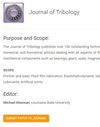考虑叶间接触和摩擦的气动翼型轴承静特性预测
IF 3
3区 工程技术
Q2 ENGINEERING, MECHANICAL
引用次数: 0
摘要
建立了气动翼型轴承的弹流动力学模型,研究了稳态条件下转子转速、轴承部件间摩擦系数、载荷等参数对气动翼型轴承叶片位移的影响。采用数值模拟的方法对气动翼型轴承的静态特性进行了预测。结果表明,在轴承两端,箔片的径向位移最小,在轴承中部最大,而顶部箔片在远离最大压力处沿轴承宽度变化平缓。增加转速后,最大流体压力提高,作用位置移位,转速的增加对最大流体压力有显著影响。提高凹凸箔与轴承套筒之间的摩擦系数μ2对凹凸箔的位移有不同的影响。当μ1为0.1时,通过提高μ2,顶箔在压力峰处的横向位移增大20.9%,纵向位移减小8.9%,凸箔的横向位移和最大纵向负位移分别减小53.2%和31.7%。载荷的增加减小了碰撞箔固定端纵向位移,相同载荷下各构件间摩擦系数的相对大小影响碰撞箔位移的大小和方向。本文章由计算机程序翻译,如有差异,请以英文原文为准。
Prediction of static characteristics of hydrodynamic air foil bearing considering contact and friction between foils
The elastohydrodynamic model of hydrodynamic air foil bearing has been built to study the influence of rotor speed, the friction coefficient between bearing components, load and other parameters on the foil displacement of hydrodynamic air bearing under steady-state conditions. The static characteristics of hydrodynamic air foil bearing are predicted by using the numerical simulation method. The results show that the radial displacement of the foil is the smallest at both ends of the bearing and the largest at the middle of the bearing, while the top foil changes gently along the width of the bearing away from the maximum pressure. After increasing the rotating speed, the maximum fluid pressure improves and the action position shifts, and the increase of rotating speed has a significant impact on the maximum pressure. improving the friction coefficient μ2 between the bump foil and the bearing sleeve has different effects on the displacement of the foil. When μ1 is 0.1, by promoting μ2, the transverse displacement of the top foil at the pressure peak increases by 20.9%, the longitudinal displacement is reduced by 8.9%, the transverse displacement and the maximum longitudinal negative displacement of the bump foil are decreased by 53.2% and 31.7% respectively. Furthermore, the longitudinal displacement of bump foil at the fixed end has been reduced by increasing the load, and the relative size of the friction coefficient between the components affects the size and direction of the foil displacement at the same load.
求助全文
通过发布文献求助,成功后即可免费获取论文全文。
去求助
来源期刊
CiteScore
4.20
自引率
12.00%
发文量
117
审稿时长
4.1 months
期刊介绍:
The Journal of Tribology publishes over 100 outstanding technical articles of permanent interest to the tribology community annually and attracts articles by tribologists from around the world. The journal features a mix of experimental, numerical, and theoretical articles dealing with all aspects of the field. In addition to being of interest to engineers and other scientists doing research in the field, the Journal is also of great importance to engineers who design or use mechanical components such as bearings, gears, seals, magnetic recording heads and disks, or prosthetic joints, or who are involved with manufacturing processes.
Scope: Friction and wear; Fluid film lubrication; Elastohydrodynamic lubrication; Surface properties and characterization; Contact mechanics; Magnetic recordings; Tribological systems; Seals; Bearing design and technology; Gears; Metalworking; Lubricants; Artificial joints

 求助内容:
求助内容: 应助结果提醒方式:
应助结果提醒方式:


